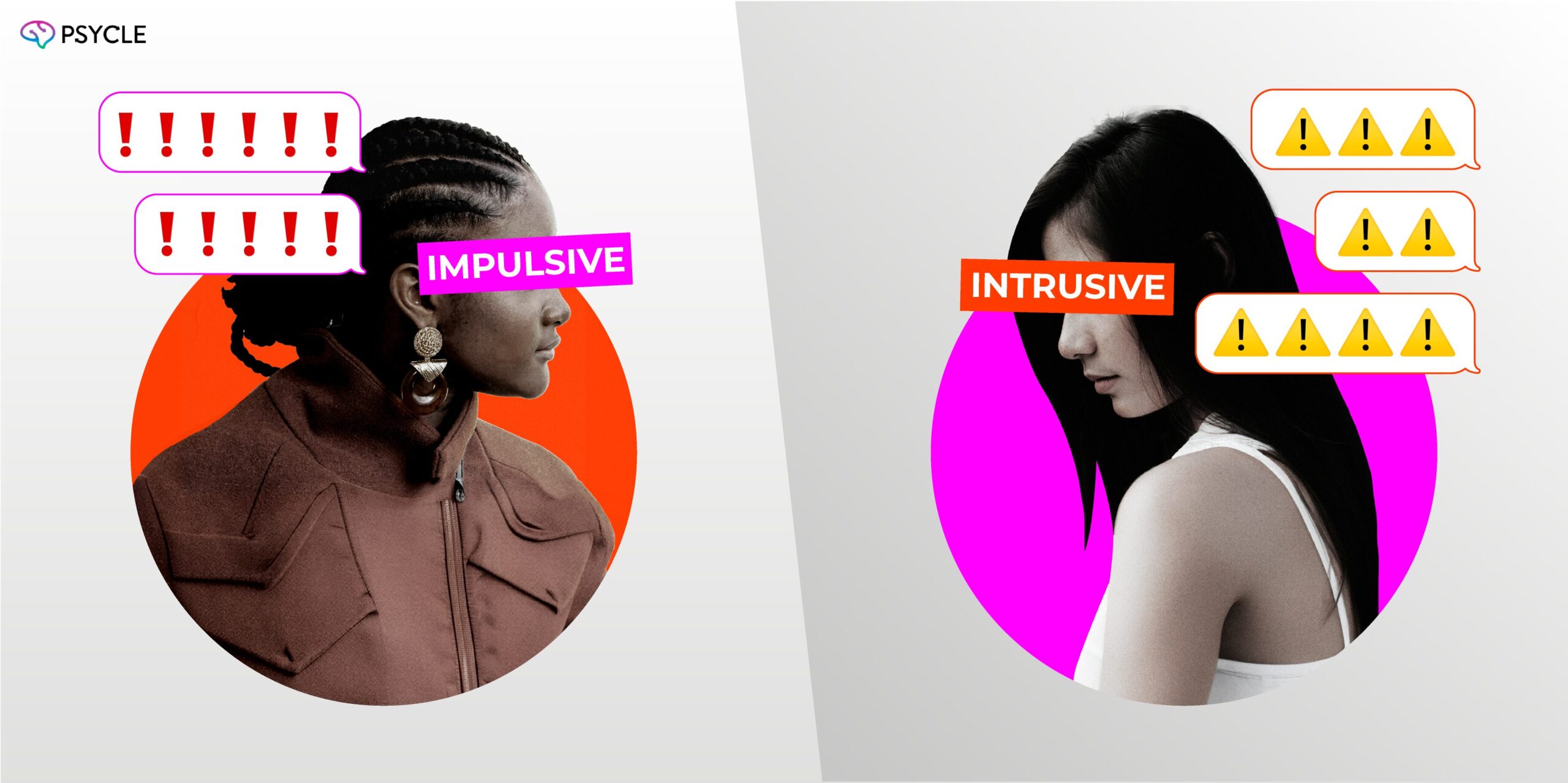Have you ever wondered about the differences between impulsive thoughts and intrusive thoughts and how they can impact our lives?
Let’s dive in and better understand what’s the difference between intrusive and impulsive thoughts.
Key Takeaways
- Intrusive thoughts are unwanted, persistent, and disturbing thoughts or images that can cause distress and disruption.
- Impulsive thoughts are action-oriented and often pleasurable thoughts and behaviors that stem from desires and spontaneity.
- Intrusive thoughts are ego-dystonic (clash with your values), while impulsive thoughts are ego-syntonic (align with momentary desires).
- Effective coping strategies and therapy can help individuals manage intrusive thoughts and, if necessary, overcome obsessive-compulsive disorder.
- ERP therapy is the gold standard for treating intrusive thoughts, while DBT is highly effective for impulsive behaviors.
- Impulsive thoughts can lead to risky actions and have physical and psychosocial consequences, often associated with drug dependence and certain mental health conditions.
Intrusive vs. Impulsive Thoughts: What’s the Difference?
Intrusive thoughts are unwanted thoughts that creep into an individual’s mind and cause some kind of mental pain. Many a time, these ideas strike the person without prior notice and often pertain to some sort of fear, anxiety, or unacceptable situation that is usually considered complex to dismiss and, hence, a significant cause of stress.
On the other hand, impulsive thoughts are spontaneous and typically result in decision-making or actions carried out in an instant without much thought about the possible outcomes. On average, these thoughts are usually inspired by an urge or impulse to do something at the moment.
While intrusive thoughts have more to do with unwanted and horrifying ideas, impulsive thoughts are those that have a relation to actions that occur impulsively, in most cases, without rational thinking about them.
Understanding the difference between these forms of thought can help manage them better. Thus, being able to perceive an invasive thought as a fast, uninvited idea and not a reflection of what you want to do could make the resulting reduction less intense. For impulsive thoughts, practicing mindfulness and pause techniques can help prevent rash decisions.
The Role of Anxiety in Both Thought Types
While intrusive and impulsive thoughts differ significantly, anxiety plays a crucial role in both experiences. Understanding this connection can help explain why these thoughts intensify during stressful periods.
For intrusive thoughts, anxiety acts as an amplifier. When you’re anxious, your brain becomes hypervigilant to potential threats. Random, disturbing thoughts that would normally pass unnoticed get flagged as “important” or “dangerous,” creating a cycle where the more you worry about the thought, the more frequently it appears. This explains why intrusive thoughts often worsen during periods of high stress or uncertainty.
For impulsive thoughts, anxiety can trigger impulsivity as a means of escape. When feeling anxious or uncomfortable, the urge to act immediately—whether it’s making an impulsive purchase, sending that text you shouldn’t, or indulging in emotional eating—provides temporary relief from distressing emotions. However, this creates a problematic feedback loop: acting on impulses may bring short-term relief but often leads to consequences that increase anxiety in the long run.
Understanding this anxiety connection is crucial because effective treatment for both types of thoughts often involves anxiety management techniques alongside targeted interventions.
Characteristics of Intrusive and Impulsive Thoughts
Understanding the characteristics of intrusive thoughts versus impulsive thoughts can provide valuable insights into their effects and implications.

Characteristics of Intrusive Thoughts
Intrusive thoughts often arise in individuals who have experienced anxiety or trauma. These thoughts are unwanted, disturbing, and persistent, constantly intruding upon their consciousness. They can take the form of distressing, violent, or explicit images or ideas, causing significant distress and disruption in daily life.
They can occur in individuals without any mental health conditions, but are especially prevalent in individuals with anxiety disorders and post-traumatic stress disorder (PTSD). Intrusive thoughts are like spam emails for the mind, constantly popping up and demanding attention.
The main characteristics of intrusive thoughts include:
- Unwanted: Intrusive thoughts are intrusive because they are unwanted and involuntary. Individuals often try to suppress or ignore these thoughts, but they can be persistent and intrusive.
- Disturbing: Intrusive thoughts are often disturbing and can evoke strong emotional reactions, such as fear, guilt, or shame.
- Persistent: Intrusive thoughts can persistently recur, making it difficult for individuals to focus on other tasks or thoughts.
- Unrealistic: These thoughts are often unrealistic and not in line with an individual’s true desires or beliefs. They can involve irrational fears or worries.
- Ego-dystonic: These thoughts are “ego-dystonic,” meaning they clash directly with your values, beliefs, and sense of self—which is exactly what makes them so distressing. You’re horrified by these thoughts precisely because they contradict who you are.
Intrusive Thoughts Examples
Intrusive thoughts might be of any form and differ significantly from one individual to another. Common examples include:
- Fear of harming others: Worrying you might accidentally hurt someone, but you don’t have any wish or intention to do so.
- Obsessive fears of contamination: Repeated thoughts about germs, dirt, or contamination, leading to compulsive cleaning or avoidance of certain places.
- Relationship OCD (ROCD): Unwanted doubts about a partner or your feelings, despite an excellent romantic relationship, or constant questioning whether you truly love your partner.
- Sexual obsessions: Unwanted sexual thoughts can be disturbing or conflict with your values and beliefs, including fears about inappropriate attraction.
- Religious/moral obsessions: Preoccupation with themes about sinning, blasphemous or taboo thoughts, concerns with moral responsibility and purity.
- Superstitious thinking: Belief that having certain thoughts will cause bad things to happen to loved ones, leading to mental rituals to “undo” the thoughts.
- Contamination beyond germs: Intrusive worry that you’ve been exposed to toxins, poisons, or dangerous substances even without evidence.
Characteristics of Impulsive Thoughts
Impulsive thoughts stem from desires and spontaneity. They are action-oriented and often associated with seeking immediate gratification or indulging in pleasurable experiences. Impulsive thoughts can manifest as impulsive behaviors, where individuals act without thinking of the consequences.
Impulsive thoughts are like a surge of adrenaline, pushing us to act without thinking.
The main characteristics of impulsive thoughts include:
- Action-oriented: Impulsive thoughts are often focused on immediate actions or behaviors, driven by a desire for instant gratification or to fulfill a spontaneous impulse.
- Pleasurable: Impulsive thoughts are often associated with pleasurable experiences or gratification, leading individuals to engage in impulsive behaviors without considering potential risks or negative outcomes.
- Risky: Impulsive thoughts can lead individuals to engage in risky behaviors or make impulsive decisions without fully considering the consequences or potential harm.
- Regret: Impulsive thoughts may be followed by feelings of regret or remorse as individuals realize the potential negative consequences of their impulsive actions.
- Ego-syntonic: These thoughts are typically “ego-syntonic,” meaning they align with desires you actually have in the moment, even if you later regret acting on them. Unlike intrusive thoughts, impulsive thoughts feel like “you” at the time—they reflect genuine desires that bypass rational thinking.
Impulsive Thoughts Examples
Impulsive thoughts can lead to spontaneous actions without much consideration for the consequences. Here are some common examples:
- Spontaneous spending: The sudden urge to buy something expensive or unnecessary while shopping, driven by a momentary desire rather than a planned need.
- Blurting out: Saying something inappropriate or hurtful without thinking, often regretting it immediately after.
- Risky behaviors: Engaging in activities like reckless driving, gambling, or extreme sports on a whim, motivated by the thrill or excitement of the moment.
- Emotional eating: Grabbing and consuming a large amount of food quickly when feeling stressed or emotional, without thinking about the health implications.
- Sudden changes in plans: Making abrupt decisions to change plans or routines, such as quitting a job or booking an impromptu trip, driven by a fleeting urge.
- Social media and technology impulsivity: Compulsively checking your phone mid-conversation, posting something you later regret, or doomscrolling despite intending to sleep.
- Relationship impulsivity: Sudden urge to end a relationship during an argument or make major relationship decisions without deliberation.
- Self-sabotage: Urge to quit something you’ve worked hard for right before completion, driven by anxiety or fear of success.
Understanding the Ego-Dystonic vs. Ego-Syntonic Distinction
This distinction between ego-dystonic and ego-syntonic thoughts is crucial for understanding why intrusive and impulsive thoughts feel so different, despite both being unwanted at times.
Intrusive thoughts are ego-dystonic: They feel alien and wrong because they directly oppose your core values and identity. A loving parent having intrusive thoughts about harming their child is horrified because such thoughts contradict everything they believe about themselves. The distress comes from the conflict between the thought and the person’s true self.
Impulsive thoughts are ego-syntonic: They feel like genuine desires in the moment, even if they conflict with long-term goals or rational judgment. When you impulsively buy something you can’t afford, you genuinely want that item at the time—the regret comes later when you face consequences, not from the thought itself, contradicting who you are.
This is why treatment approaches differ: intrusive thoughts require learning that these thoughts are meaningless mental noise, while impulsive thoughts require developing pause mechanisms before acting on genuine-but-unwise desires.
Impulsive vs. Compulsive vs. Intrusive: Understanding All Three
Impulsive, compulsive, and intrusive thoughts are often confused, but understanding the distinctions between all three is essential for proper treatment and management.
Impulsive thoughts and behaviors are spontaneous actions taken without forethought, often driven by an urge or desire for immediate gratification. Examples include making an unplanned purchase, blurting out something without thinking, or engaging in risky activities. The key characteristic is their sudden and unplanned nature—you genuinely want to do the action at the time.
Compulsive behaviors, however, are repetitive actions performed to reduce anxiety or prevent a feared event, often as part of a ritual. These behaviors are usually driven by intrusive thoughts, for example, repeatedly checking if the door is locked, excessive handwashing, or counting objects. Unlike impulsive behaviors, compulsive actions are usually planned and are performed to alleviate distress rather than out of a sudden urge.
Intrusive thoughts are the unwanted, distressing mental content that often triggers compulsive behaviors. They’re the “obsessions” in obsessive-compulsive disorder (OCD).
Key Differences Comparison
| Aspect | Intrusive Thoughts | Impulsive Thoughts | Compulsive Behaviors |
| Definition | Unwanted, distressing thoughts/images | Sudden urges to act for gratification | Repetitive rituals to reduce anxiety |
| Motivation | Ego-dystonic (against your values) | Ego-syntonic (align with momentary desires) | Driven by anxiety from intrusive thoughts |
| Action Taken | Actively resisted; person doesn’t want to act | Often acted upon quickly | Must be performed to reduce distress |
| Emotional Response | Distress, horror, guilt about having the thought | Excitement or desire, then possible regret | Temporary relief followed by renewed anxiety |
| Associated Conditions | OCD, PTSD, anxiety disorders, depression | ADHD, bipolar disorder, BPD, substance use | OCD (paired with intrusive thoughts) |
| Example | “What if I hurt someone I love?” | “I need to buy this now!” | Checking locks 10 times before bed |
The OCD Connection
It’s crucial to understand that OCD involves both intrusive thoughts (obsessions) and compulsive behaviors (compulsions) working together in a cycle:
- Intrusive thought appears (“What if I left the stove on and the house burns down?”)
- Anxiety spikes (intense fear and distress)
- Compulsive behavior performed (checking the stove repeatedly)
- Temporary relief (anxiety decreases briefly)
- Cycle reinforces (brain learns that checking “prevents” disaster, making the cycle stronger)
Understanding these differences can help determine the right treatment approach. Impulsive actions might be reduced through strategies that increase self-control and the capacity for delayed gratification, such as Dialectical Behavior Therapy (DBT).
Compulsive behaviors are treated with techniques that address the underlying anxiety and interrupt the learned ritualistic behavior, particularly Exposure and Response Prevention (ERP) therapy. The key is recognizing which pattern you’re experiencing to pursue the most effective treatment.
Can You Have Intrusive Thoughts Without OCD?
Yes—experiencing intrusive thoughts does NOT automatically mean you have OCD. This is one of the most important distinctions to understand.
Research shows that 94% of people experience intrusive thoughts at some point in their lives. The difference between normal intrusive thoughts and OCD lies in how these thoughts are experienced and managed.
Normal Intrusive Thoughts vs. OCD
Normal intrusive thoughts:
- Occur occasionally and pass relatively quickly
- May be briefly unsettling but don’t cause prolonged distress
- Don’t significantly interfere with daily activities
- Don’t lead to compulsive behaviors
- Can be dismissed or redirected without intense effort
Intrusive thoughts in OCD:
- Become persistent, recurring obsessions that consume significant mental energy
- Cause intense, prolonged anxiety and distress
- Lead to compulsive behaviors (mental or physical rituals) to neutralize the anxiety
- Significantly interfere with daily functioning, relationships, or work
- Create a cycle: obsession → anxiety → compulsion → temporary relief → repeat
Other Conditions Featuring Intrusive Thoughts
Intrusive thoughts also occur in:
- Generalized Anxiety Disorder (GAD): Excessive worrying about various life areas, often involving “what if” scenarios
- Post-Traumatic Stress Disorder (PTSD): Flashbacks, trauma-related memories, or fears that intrude unexpectedly
- Depression: Negative, self-critical thoughts or fears about being a burden to others
- Perinatal Mental Health Issues: New parents experiencing disturbing thoughts about their baby’s safety
When to Seek Help
Consider seeking professional help if your intrusive thoughts:
- Occur multiple times per day and persist for weeks or months
- Cause significant distress that affects your mood, sleep, or functioning
- Lead you to avoid certain situations, places, or people
- Result in repetitive behaviors or mental rituals to cope
- Make you question your own character or fear you might act on the thoughts
If you’re unsure whether your intrusive thoughts require professional support, speaking with a mental health provider can help clarify whether treatment would be beneficial.
Impact of Intrusive and Impulsive Thoughts
Intrusive thoughts can have significant effects on individuals, causing feelings of distress and disruption in daily life. These thoughts are often unwanted, disturbing, and persistent, and can create intense emotional experiences.
Despite their distressing nature, it is important to note that the thoughts themselves are similar to those occurring in the general population. This means that experiencing intrusive thoughts does not necessarily indicate the presence of an underlying mental health condition but rather a common experience.
On the other hand, impulsive thoughts can lead to dangerous or harmful behaviors. When individuals act impulsively without considering the potential consequences, it can result in regrettable actions and negative outcomes. These impulsive behaviors may be driven by desires, spontaneity, or a lack of impulse control.
Both intrusive and impulsive thoughts can significantly impact an individual’s daily life, relationships, and overall well-being. Understanding the effects and consequences of these thoughts is crucial in order to develop effective coping strategies and seek appropriate support when needed.
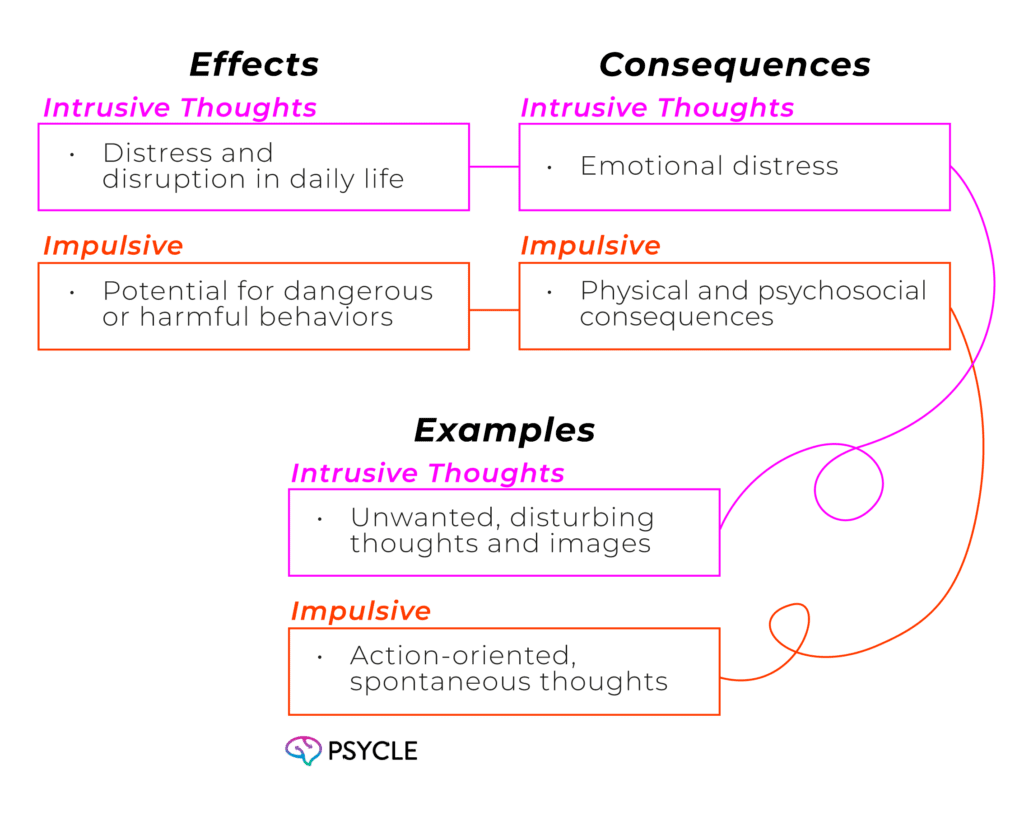
Prevalence of Intrusive and Impulsive Thoughts
Unwanted, intrusive thoughts and impulsive thoughts are common experiences among individuals. These thoughts can significantly impact daily life and mental well-being. Understanding the prevalence of intrusive and impulsive thoughts can help shed light on the frequency of these occurrences.
94% of people experience unwanted, intrusive thoughts and images at some point in their lives. Intrusive thoughts, characterized by their unwanted and disturbing nature, are prevalent among a wide range of individuals. These thoughts often involve distressing content and persistently intrude into one’s mind, causing significant anxiety and disruption.
The prevalence of impulsive thoughts varies widely depending on underlying conditions. Impulsivity is a core feature of ADHD, which affects 5-7% of adults in the United States. It also appears in varying degrees in bipolar disorder, borderline personality disorder, and substance use disorders.
However, everyone experiences occasional impulsive thoughts—it’s the frequency, intensity, and consequences that determine whether professional help is needed.
Coping Strategies for Intrusive Thoughts
When it comes to coping with intrusive and impulsive thoughts, effective cognitive and behavioral interventions can make a significant difference. While specific coping strategies for impulsive thoughts are covered in the treatment section below, here are immediate techniques for managing intrusive thoughts:
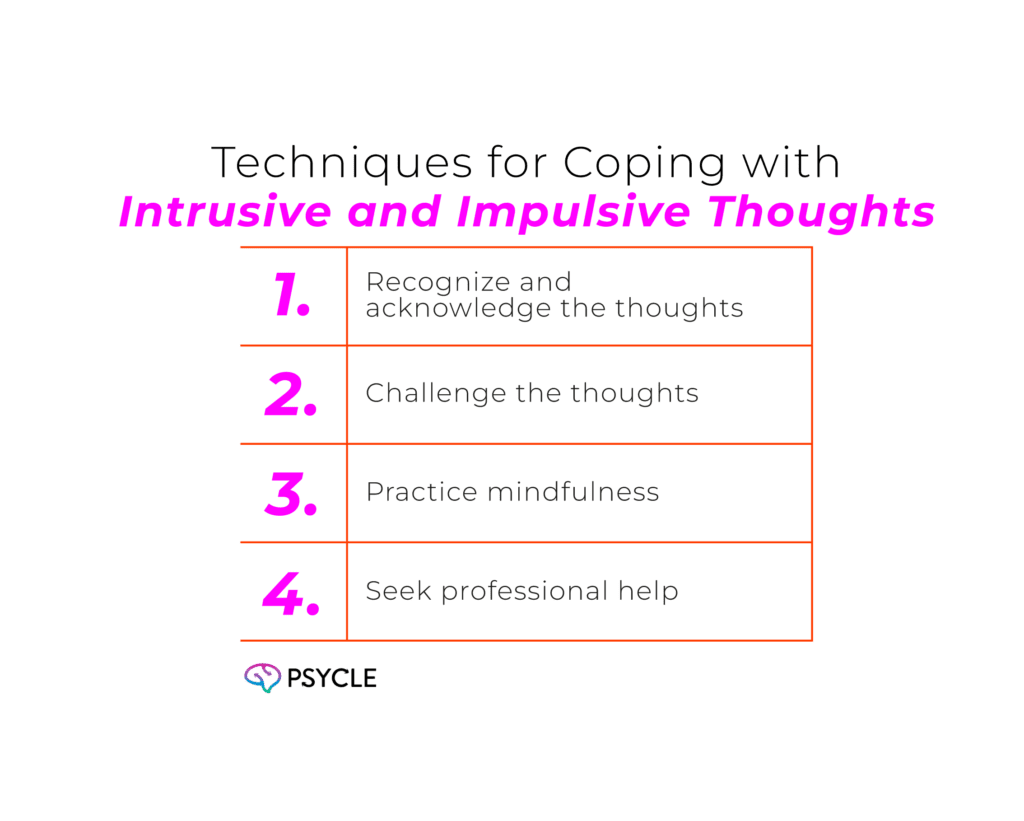
1. Recognize and Acknowledge the Thoughts
Start by acknowledging that intrusive thoughts are a normal part of the human experience. Understand that having these thoughts does not make you a bad person and that they do not define you. Recognizing their presence can help you distance yourself from them and prevent them from taking control.
2. Challenge the Thoughts
Question the validity and accuracy of your intrusive thoughts. Ask yourself if there is any real evidence to support them or if they are based on fears, anxieties, or past experiences. Challenging these thoughts can help you gain a more realistic perspective and reduce their impact on your emotions and behaviors.
3. Practice Mindfulness
Mindfulness techniques can be incredibly helpful in managing intrusive and impulsive thoughts. Engage in activities such as meditation, deep breathing exercises, or journaling to stay present in the moment and avoid getting caught up in your thoughts. This can help create a sense of calm and detachment from intrusive and impulsive thinking patterns.
4. Use Thought Defusion Techniques
Try labeling intrusive thoughts by saying “I’m having the thought that…” or “My anxiety is telling me…” This creates psychological distance between you and the thought, reminding you that thoughts are just mental events, not facts or predictions.
5. Practice Self-Compassion
Dealing with frequent intrusive thoughts can be exhausting and upsetting. Remember to practice self-compassion and remind yourself that these thoughts are not your fault and don’t reflect who you are. Treat yourself with the same empathy and understanding you would offer a friend in a similar situation.
Treatment Approaches for Intrusive and Impulsive Thoughts
Understanding the difference between intrusive and impulsive thoughts is only the first step—knowing how to effectively treat them is crucial for long-term management and improved quality of life. Different therapeutic approaches work best for each type of thought pattern.
Treatment for Intrusive Thoughts
Exposure and Response Prevention (ERP): The Gold Standard
Exposure and Response Prevention (ERP) is a specialized form of Cognitive-Behavioral Therapy that was developed specifically to treat OCD and has proven to be highly effective for managing intrusive thoughts. ERP involves two key components:
Exposure: Gradually and systematically confronting the situations, thoughts, or images that trigger your obsessions and anxiety. This is done in a controlled, therapeutic setting with your therapist’s guidance.
Response Prevention: Learning to resist performing compulsions—the mental or physical rituals you normally use to reduce anxiety. By preventing these responses, you break the cycle that reinforces OCD.
Real-world example: Consider someone with OCD who has recurrent intrusive thoughts about jumping in front of a train. This disturbing image is extremely upsetting, and they don’t want to act on it. In response, they avoid all public transportation and perform mental rituals, like counting to 10 or mentally reviewing why they wouldn’t actually jump.
In ERP therapy, this person would work with their therapist to gradually face these fears without performing compulsions:
- Start by looking at pictures of trains
- Progress to watching videos of trains
- Eventually visit a train station (with therapist support)
- Practice standing on a platform while resisting mental rituals
- Learn that anxiety naturally decreases over time without compulsions
The goal of ERP isn’t to eliminate intrusive thoughts—it’s learning that intrusive thoughts don’t predict future events, don’t define who you are, and don’t require a compulsive response. Throughout the process, you learn to tolerate uncertainty and reduce the need for compulsions.
Cognitive Behavioral Therapy (CBT)
CBT helps identify and challenge thought patterns that maintain anxiety and distress. For intrusive thoughts, CBT teaches you to recognize cognitive distortions (like catastrophizing or thought-action fusion) and develop more balanced perspectives.
Acceptance and Commitment Therapy (ACT)
Acceptance and Commitment Therapy (ACT) focuses on accepting unwanted thoughts rather than fighting them, while committing to actions aligned with your values. ACT teaches psychological flexibility—the ability to be present with uncomfortable thoughts without being controlled by them.
Medication Management
In some cases, medication may be recommended alongside therapy:
- SSRIs (Selective Serotonin Reuptake Inhibitors): Often prescribed for OCD and anxiety disorders
- SNRIs (Serotonin-Norepinephrine Reuptake Inhibitors): Alternative for anxiety and depression
- Medication works best when combined with therapy like ERP
Treatment for Impulsive Thoughts
Dialectical Behavior Therapy (DBT)
DBT is highly effective for managing impulsivity, particularly for individuals with borderline personality disorder, emotional dysregulation, or substance use issues. DBT focuses on four core skills:
- Mindfulness: Becoming aware of impulsive urges before acting on them
- Distress Tolerance: Learning to tolerate uncomfortable emotions without impulsive reactions
- Emotion Regulation: Understanding and managing intense emotions that trigger impulsivity
- Interpersonal Effectiveness: Communicating needs without impulsive outbursts
Cognitive Behavioral Therapy (CBT) for Impulsivity
CBT helps identify triggers for impulsive behavior and develop alternative responses. Techniques include:
- Creating a “pause button” between impulse and action
- Challenging thoughts that justify impulsive behavior
- Developing consequence-forecasting skills
Impulse Control Training
Specific techniques to manage impulsive urges:
- Delay techniques: “Wait 10 minutes” rule before acting on impulses
- STOP skill: Stop, Take a step back, Observe, Proceed mindfully
- Cost-benefit analysis: Quick mental calculation of pros/cons before acting
Medication Management
For conditions associated with impulsivity:
- Stimulants: For ADHD-related impulsivity (methylphenidate, amphetamines)
- Mood stabilizers: For bipolar disorder (lithium, valproate)
- Atypical antipsychotics: Sometimes used for severe impulsivity
- SSRIs: May help with impulsivity in certain contexts
Finding the Right Professional
Choosing a therapist with the right specialization is crucial:
For intrusive thoughts and OCD:
- Look for therapists specifically trained in ERP
- Ask: “What percentage of your practice is treating OCD?”
- Ideal answer: 50% or more
- Organizations like the International OCD Foundation (IOCDF) maintain therapist directories
For impulsive thoughts:
- Seek therapists trained in DBT or impulse control disorders
- For ADHD-related impulsivity, look for ADHD specialists
- Ask about experience treating your specific condition (BPD, bipolar, substance use)
Red flags to avoid:
- Therapists who want to “explore why you have these thoughts” without teaching management skills
- Providers unfamiliar with ERP for OCD or DBT for impulsivity
- Anyone suggesting you can simply “stop thinking that way”
When to Seek Professional Help
Consider professional treatment if:
- Thoughts occur multiple times per day and persist for weeks or months
- Significant distress affects your mood, sleep, work, or relationships
- You’re avoiding situations, places, or people because of your thoughts
- Impulsive behaviors are causing financial, legal, or relationship problems
- You’re engaging in compulsive behaviors to cope with intrusive thoughts
- Previous attempts at self-management haven’t been effective
If you want to explore therapy options, sites like Brightside offer a free mental health assessment. Just complete their 4-minute questionnaire, and you’ll get a personalized treatment plan and an appointment for a virtual session with a professional in less than 48 hours.
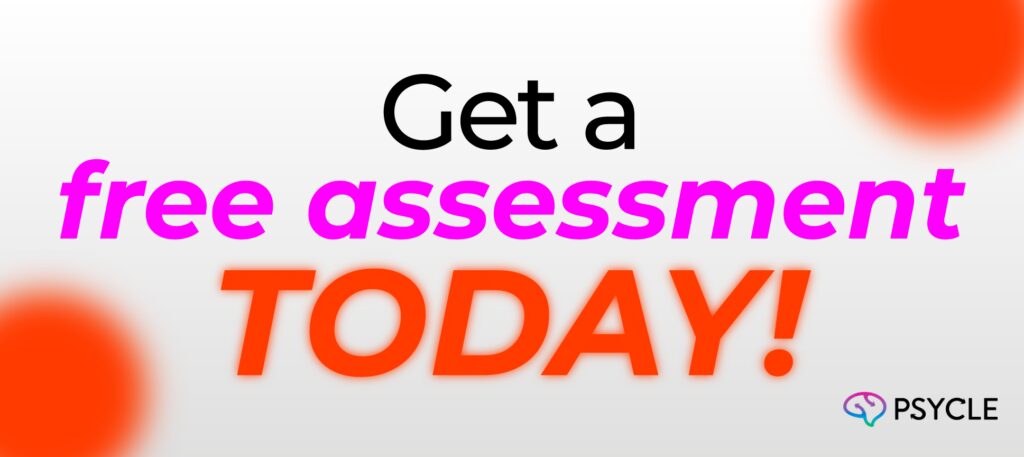
By employing these coping strategies, individuals can take control of their thoughts and reduce the distress and disruption associated with intrusive thoughts.
Disorders Associated with Intrusive and Impulsive Thoughts
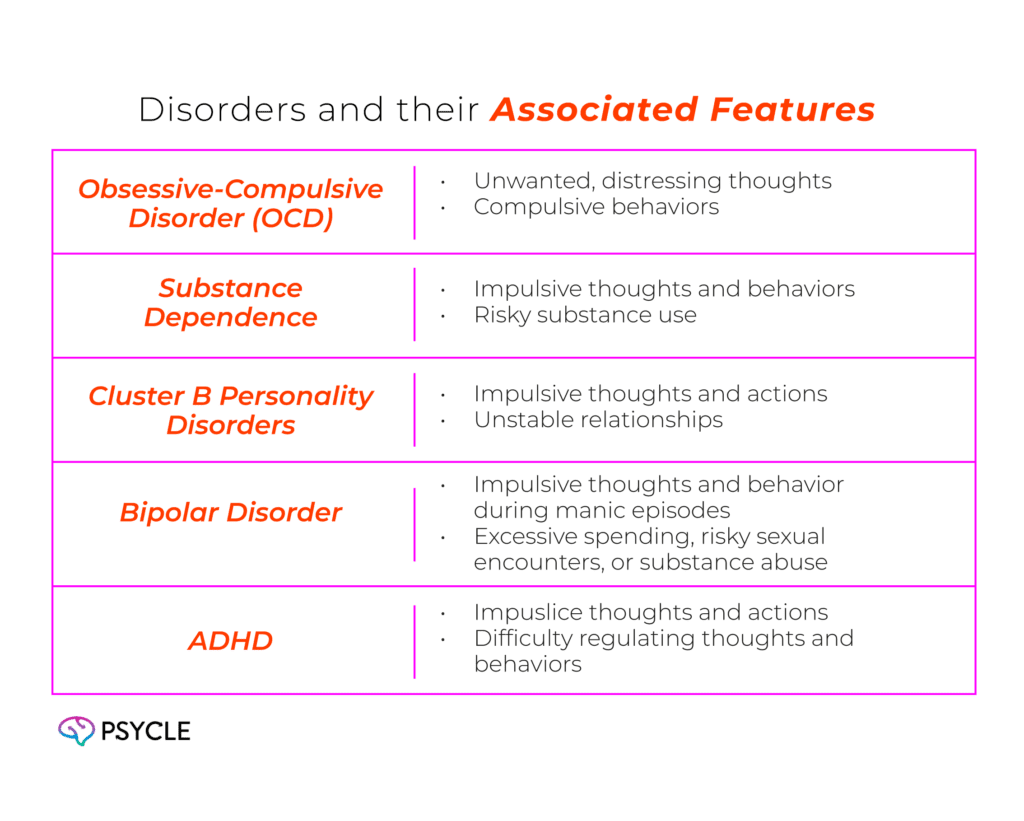
Individuals experiencing intrusive thoughts are often diagnosed with obsessive-compulsive disorder (OCD). These unwanted, distressing thoughts are a hallmark symptom of OCD, accompanied by compulsions or repetitive behaviors that individuals engage in to alleviate anxiety.
For instance, a person may have intrusive thoughts about harming themselves or others and subsequently feel compelled to perform rituals or specific actions to alleviate the distress caused by these thoughts.
Conversely, impulsive thoughts are often associated with a range of mental health conditions and behaviors:
- Drug Dependence: Impulsive thoughts and behaviors are commonly observed in individuals struggling with substance abuse and dependence. The impulsivity may contribute to a cycle of substance use and further reinforce addictive behaviors.
- Cluster B Personality Disorders: Conditions such as borderline personality disorder, narcissistic personality disorder, and antisocial personality disorder are characterized by impulsive thoughts and actions. Individuals with these disorders may engage in risky behaviors, have unstable relationships, and struggle with impulse control.
- Bipolar Disorder: During manic episodes, individuals with bipolar disorder may experience impulsive thoughts and engage in impulsive behaviors, such as excessive spending, risky sexual encounters, or substance abuse.
- ADHD: Attention-deficit/hyperactivity disorder (ADHD) is associated with impulsive thoughts and impulsive behaviors. Individuals with ADHD often struggle with impulse control and have difficulty regulating their thoughts and actions.
While these associations provide insights into the relationship between certain mental health disorders and impulsive thoughts, it’s essential to consult with a qualified mental health professional for an accurate diagnosis and appropriate treatment.
Conclusion
Understanding the difference between intrusive and impulsive thoughts is crucial for effectively managing these experiences and seeking appropriate therapy. Intrusive thoughts, characterized by unwanted, disturbing, and persistent thoughts and images, often stem from anxiety and trauma. In contrast, impulsive thoughts are action-oriented and driven by desires and spontaneity.
By recognizing the origins and characteristics of intrusive and impulsive thoughts, individuals can develop coping strategies to navigate them more effectively. Cognitive and behavioral interventions have proven to be particularly successful in managing intrusive thoughts associated with conditions like obsessive-compulsive disorder (OCD). Seeking therapy in these instances can be immensely beneficial.
Similarly, understanding impulsive thoughts and their potential consequences is essential for avoiding risky behaviors and preventing harm. For those experiencing impulsive thoughts related to drug dependence, personality disorders, bipolar disorder, or ADHD, seeking professional help and therapy is crucial for managing and addressing these underlying conditions.
Overall, by gaining a deeper understanding of intrusive and impulsive thoughts, individuals can take proactive steps towards managing their thoughts and seeking therapy when needed.
FAQs
What’s the Difference Between Intrusive and Impulsive Thoughts?
Intrusive thoughts are unwanted, disturbing, and persistent thoughts and images that are ego-dystonic (clash with your values), often associated with anxiety and trauma. Impulsive thoughts are action-oriented thoughts that are ego-syntonic (align with momentary desires), leading to spontaneous behaviors driven by desires for immediate gratification.
Can You Have Intrusive Thoughts Without OCD?
Yes—94% of people experience intrusive thoughts at some point. The difference in OCD is that intrusive thoughts become persistent obsessions that trigger compulsive behaviors. Intrusive thoughts also occur in anxiety disorders, PTSD, depression, and even in people without diagnosed mental health conditions.
Why Are Intrusive Thoughts So Violent or Disturbing?
The human brain generates all kinds of random content. When you’re anxious or stressed, your brain becomes hypervigilant and flags disturbing thoughts as “important” or “dangerous” when they’re actually meaningless mental noise. Intrusive thoughts are disturbing precisely because they contradict your values—they’re ego-dystonic.
What’s the Difference Between Compulsive and Impulsive Behaviors?
Compulsive behaviors are repetitive rituals performed to reduce anxiety caused by intrusive thoughts (like checking locks repeatedly). Impulsive behaviors are spontaneous actions taken for immediate gratification without considering consequences (like impulsive purchases). In OCD, you feel you “must” perform compulsions; with impulsivity, you “want” to act in the moment.
How Common are Intrusive and Impulsive Thoughts?
Approximately 94% of people experience intrusive thoughts and images. Impulsivity varies by condition—it’s a core feature of ADHD (affecting 5-7% of adults) and appears in bipolar disorder, BPD, and substance use disorders. Occasional impulsive thoughts are normal; frequency and consequences determine if help is needed.
What Are the Best Treatments for Intrusive Thoughts?
Exposure and Response Prevention (ERP) therapy is the gold standard for treating intrusive thoughts, especially in OCD. Cognitive Behavioral Therapy (CBT) and Acceptance and Commitment Therapy (ACT) are also effective. Medication (SSRIs) may be recommended alongside therapy.
What Are the Best Treatments for Impulsive Thoughts?
Dialectical Behavior Therapy (DBT) is highly effective for managing impulsivity. CBT, impulse control training techniques, and medication management (stimulants for ADHD, mood stabilizers for bipolar disorder) can also help reduce impulsive behaviors.
How do Intrusive and Impulsive Thoughts Impact Daily Life?
Intrusive thoughts can cause significant distress, anxiety, and disruption in daily activities, often leading to avoidance behaviors. Impulsive thoughts can lead to risky behaviors with physical, financial, and psychosocial consequences, including damaged relationships and regrettable decisions.
When Should I Seek Professional Help?
Seek help if thoughts occur multiple times daily, persist for weeks, cause significant distress, lead to avoidance or compulsive behaviors, or result in harmful impulsive actions. Professional treatment is highly effective for both intrusive and impulsive thoughts.
Sources
- National Institute of Mental Health. “Post-Traumatic Stress Disorder (PTSD).” https://www.nimh.nih.gov/health/topics/post-traumatic-stress-disorder-ptsd
- Psycle Health. “Why Do Intrusive Thoughts Feel So Real?” https://psyclehealth.com/mental-health/why-do-intrusive-thoughts-feel-so-real/
- National Center for Biotechnology Information. “Impulsivity: Definition, Measurement and Its Relations to Psychopathology.” https://www.ncbi.nlm.nih.gov/pmc/articles/PMC3564492/
- WebMD. “What Is Impulsivity?” https://www.webmd.com/mental-health/what-is-impulsivity
- Concordia University. “The Surprising Truth About Unwanted Intrusive Thoughts.” https://www.concordia.ca/cunews/main/stories/2014/04/08/the-surprising-truth.html
- National Institute of Mental Health. “Attention-Deficit/Hyperactivity Disorder (ADHD) Statistics.” https://www.nimh.nih.gov/health/statistics/attention-deficit-hyperactivity-disorder-adhd
- Psycle Health. “What is Acceptance and Commitment Therapy (ACT)?” https://psyclehealth.com/alternative-treatments/what-is-acceptance-and-commitment-therapy/
- National Institute of Mental Health. “Obsessive-Compulsive Disorder: When Unwanted Thoughts or Repetitive Behaviors Take Over.” https://www.nimh.nih.gov/health/publications/obsessive-compulsive-disorder-when-unwanted-thoughts-or-repetitive-behaviors-take-over
- Psychology Today. “Cluster B Personality Disorders.” https://www.psychologytoday.com/us/basics/cluster-b

